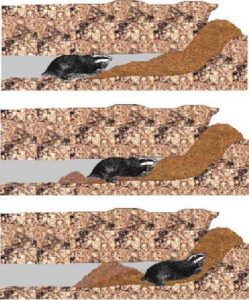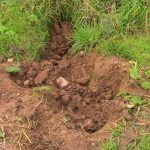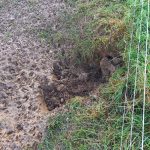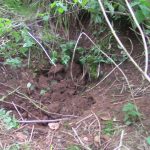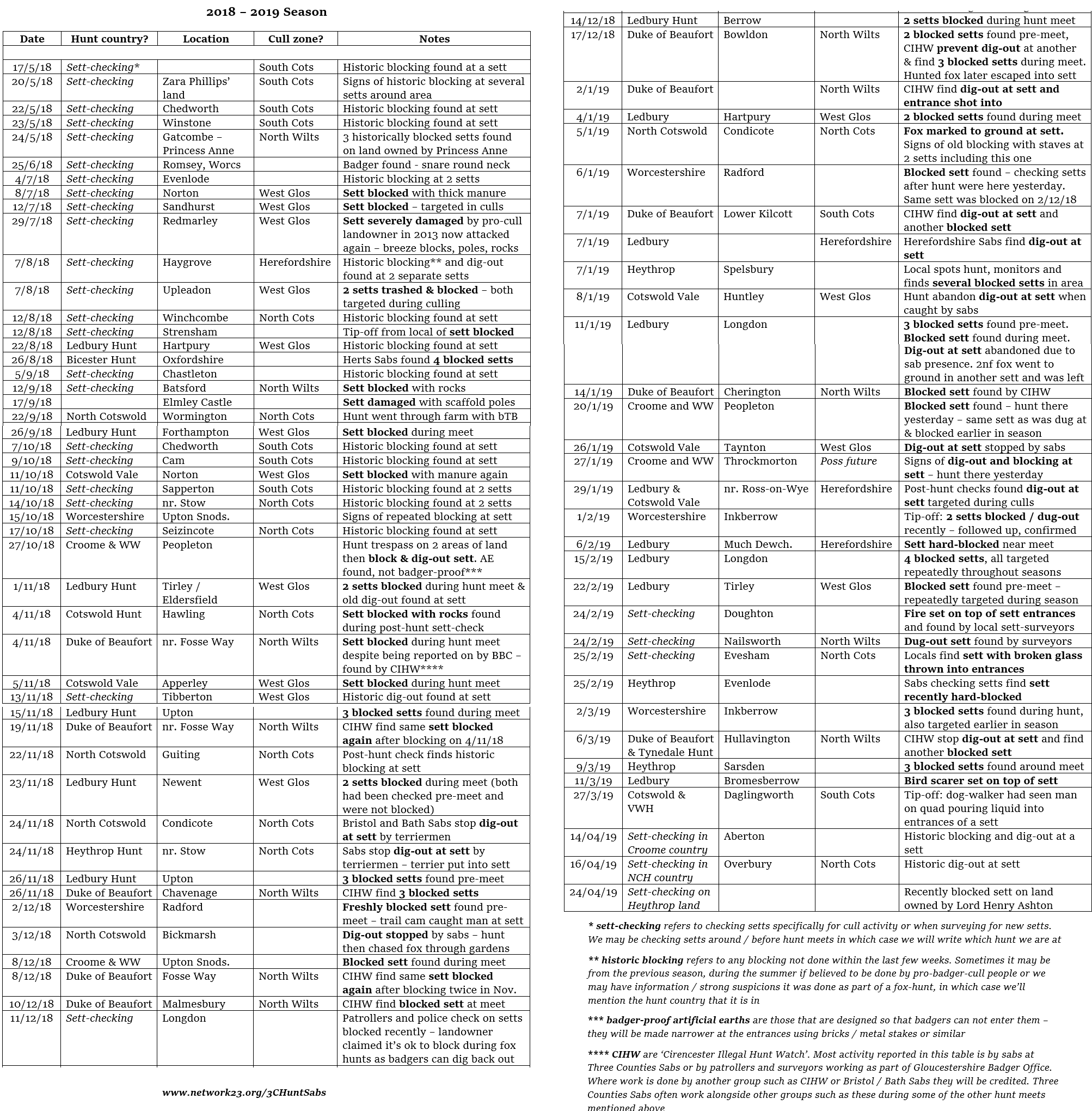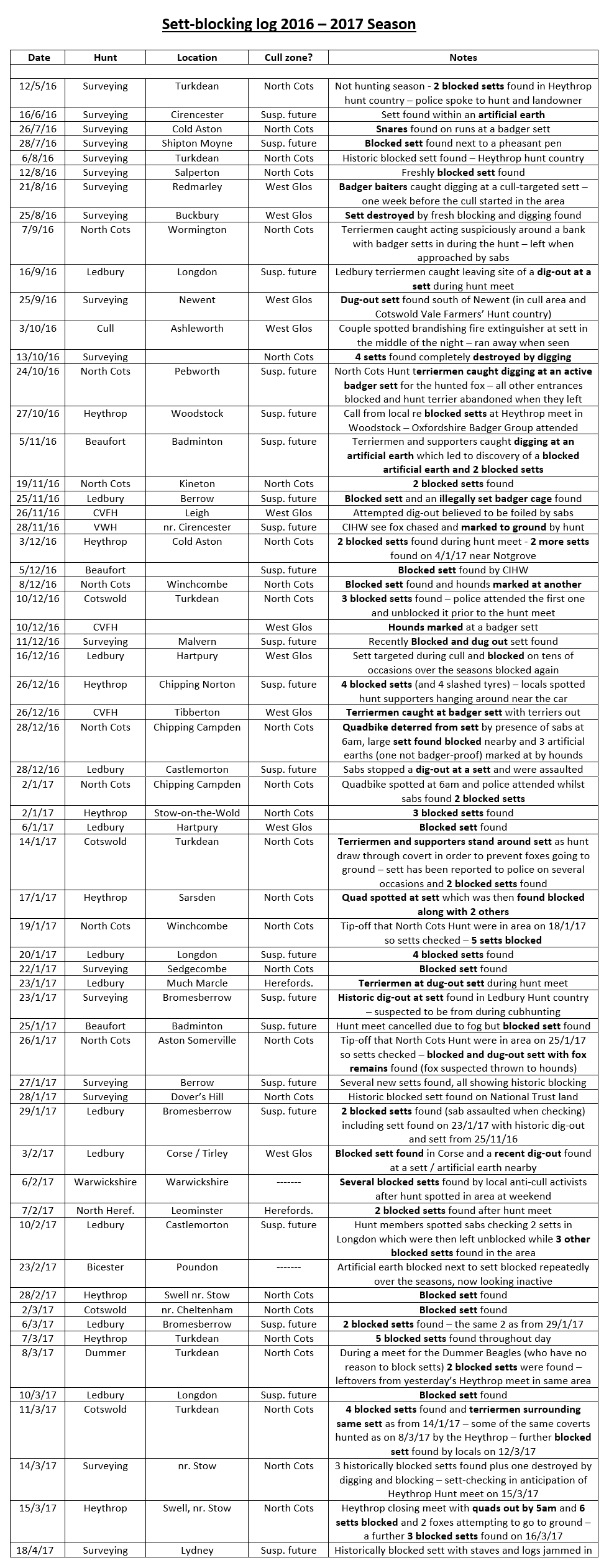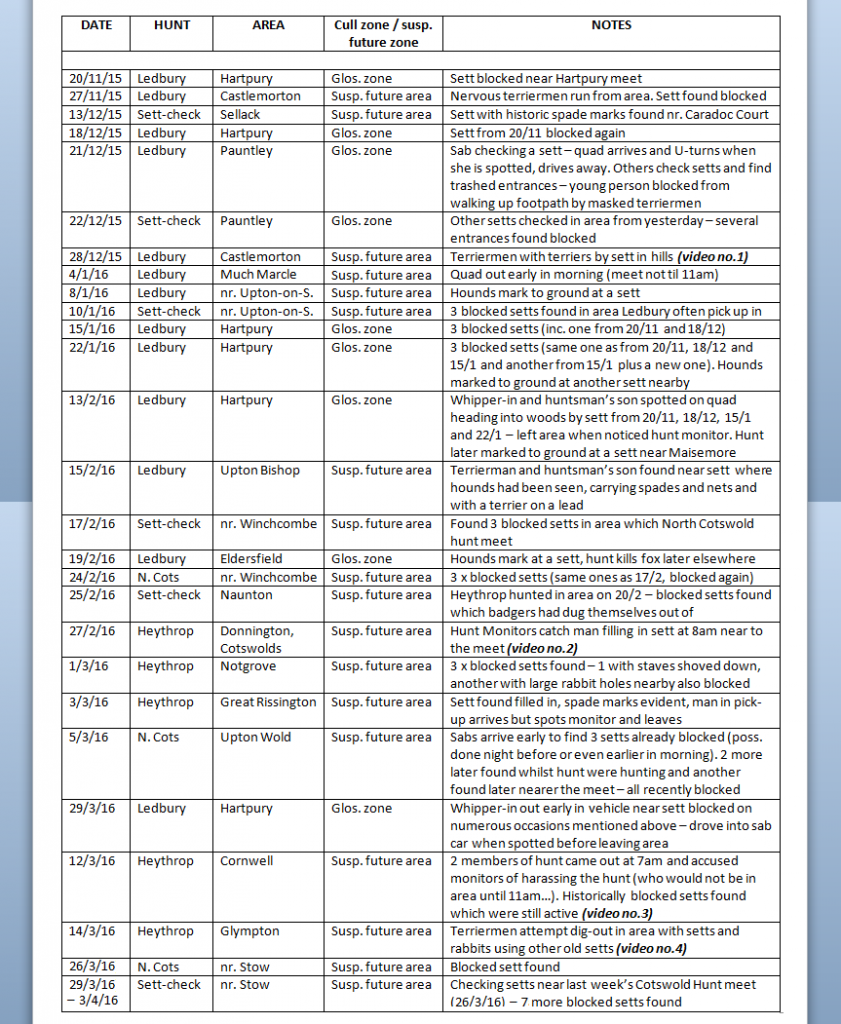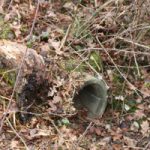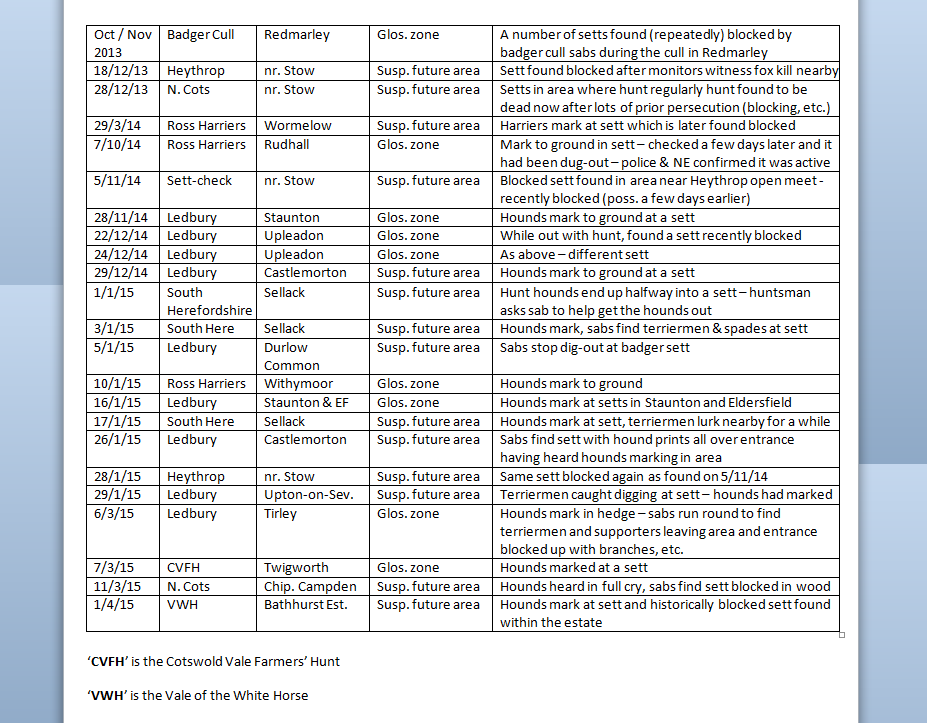The following article was originally written as a collaboration between two members of Three Counties Sabs in Spring 2016 and is updated with new data and other information as and when necessary
Update: A new page has been set up on facebook in order to raise more awareness of badger sett blocking across the country and record incidents of setts being blocked when hunts are in the area / by hunts – Stop Badger Sett Blocking
“Badgers… you may stop them in, but you can’t stop them out if they wish to get in, which is why big badger earths are such a nuisance in a hunting country…” (from ‘Hunt and Working Terriers’, Jocelyn Lucas).
This article relates to how fox hunting impacts on badgers and how setts remain vulnerable to attack by hunts despite the 1992 legislation (the Protection of Badgers Act) which criminalises damage to setts as well as badgers themselves, and the 2005 Hunting Act. The article is written by members of Three Counties Hunt Saboteurs. The first part relates to the history and hunting and the effect on badgers (and the effect of badgers on hunting). The second part of this page shows spreadsheets and videos relating to the hunts and culls in this area, so if you’re more interested in what’s going on now, scroll down.
As a group we, along with many other sab groups, sett surveyors, wildlife enthusiasts, cull sabs, etc. find many setts blocked by fox hunts. We can only recall one occasion when a sett was blocked in the heart of the Gloucestershire cull zone in 2013 by an embittered landowner, rather than a hunt. Furious that neither cages nor marksmen had killed any badgers he blocked the sett, which was unblocked by sabs… and then blocked again with earth compacting equipment by the landowner. An entrance was missed by this malevolent act and the badgers survived. Such attacks on setts are, alas, all too common but hunts have long targeted badgers by blocking setts to stop foxes escaping down them. The results can be devastating.
This article by ‘Brockwatcher’ covers an example – click here to go to the article
It highlights how badgers can be trapped when they try to dig their way out of the blocked sett as earth piles up behind them and they get trapped on both sides, dying from suffocation.
“Another problem highlighted by the NFBG (National Federation of Badger Groups) was that badgers could be physically crushed by the soil used to block their sett entrances, especially following rain. It stated: “An example of this was observed in Leicestershire in February 1995, where a badger was found trapped by the waist in a sett entrance which had been blocked by the local fox hunt”. This badger on postmortem (he was euthanised by a vet) had a ruptured spleen and had been in agony for days.”
We have seen scores of blocked setts in the last few months; we have unblocked a few by removing the stones, staves, earth and other detritus used to block the entrances and tunnels. We have also been out on dawn patrols before meets to try and catch the culprits and have deterred numerous attempts at sett blocking, often seeing known hunt staff beat a hasty retreat with a couple of confrontations thrown in.
Quite simply, hunts do not want hunted foxes disappearing down a large sett where it is very difficult to dig them out and so we find five or six blocked setts often before, during and after hunt meets and know that it is only the tip of the iceberg. Our normal sabbing and monitoring area covers not only the Gloucestershire cull zone but also the two new potential zones in Herefordshire and the Cotswolds, so we have been familiar with sett blocking antics for a while now. It was, however, only during the Gloucestershire cull when we fully realised the importance of incorporating sett checking and sett knowledge with sabbing in protecting both foxes and badgers. Fewer setts will get blocked the more you know about and check them, more foxes will escape and fewer badgers will be put at risk from suffocation.
Sett blocking, also referred to as earth stopping in earlier texts, has been part of hunting for hundreds of years. Badgers have even been described as vermin for interfering with a good hunt by having a big sett. Peter Beckford wrote in the late 18th century in his book “Thoughts on Hunting”
“You should not encourage badgers in your woods: they make strong earths, which will be expensive and troublesome to you, if you stop them; or fatal to your sport if you do not”. (page 226).
“Badgers may be caught alive in sacks placed at the mouth of the hole: setting traps for them would be too dangerous, as you might catch your foxes also: they may be caught by stinking them out of a great earth and afterwards following them to a smaller one and digging them”. (page 227).
Sounds like Beckford is talking about perturbation as a result of human intervention!
It gets worse…
“When young hounds begin to love a scent, it may be of use to turn out a badger before them. I mention a badger, on the supposition that young foxes cannot so well be spared; besides, the badger, being a slower animal, he may easily be followed and driven the way you choose he should run… I have known a badger run several miles, if judiciously managed… You should give him a great deal of law, and you would do well to break his teeth”. (pages 70-71).
The Heythrop (who hunt in the North Cotswolds) had their centenary celebrations in 1935. To celebrate, John Murray wrote “The Heythrop Hunt”. It is full of hunting reports, intricate detail of the country, the coverts, the history of the pack, hunts, dig outs, the number of horses dying after long hunts and hound breeding as well as little anecdotes. One of these is on pages 165-165 and concerns hunting badgers when Jem Hills was huntsman (he retired in 1865). N.B. badger hunting with hounds was a nocturnal activity. Apparently quoting the work of famous hunting correspondent “the Druid”, as well as Jem Hills, a badger hunt and badger hunting in general is described thus:
‘Five couple which really like it’, he went on to say, ‘will stick to it and catch a badger, where there are lots of cubs about’. Lord Dillon and Mr Webb didn’t believe me, so Lord Vaux came and had a night of it with them; hot supper at Ditchley. We sent a man at 12 to sack the hole. The run of a badger is very odd [diagram showing a weaving u shaped trail], and so on. We got on to it at the bottom of the Park, and picked it out into the Oak riding. The cubs were up, and the vixen came squalling across the rides, after the badger and the hounds, a hundred yards behind. We gave him an hour and a half in the Park, and then to ground and brought him home at 3. I used to be with the hounds under a tree, and put a man to sack the hole, and watch. They’d be out eating beans like a pig. Three and four season hunters did it best. The Rocket sort were good at that game, and Platoff was very great. If another hound spoke to a fox, he’d come back to me. His note for a badger was short and deep, and for a fox light and clear. He’d bay them, but he’d not turn them up. Harlequin knew the brisket dodge, and we dare not take him out. Badgers and foxes go very well together. They tell me that they killed nearly all the badgers in one of the woods in Sir Tatton’s old country, and there was one found the next day, and it was lying curled up in the earth with a fox. They’re friendly enough, but the foxes are the lazy ones, and the badgers do the digging, and right they should. I killed nine badgers the first season I came here, and some of them with terriers. Once I turned one out in the frost with a couple of my terriers, Cribb and Fan, and they shuffled along well. They held him till I walked a couple of miles and got a sack”.
What the fate of that poor badger was remains a mystery.
Poor Cribb the terrier “would fight a red hot poker till it became cold; his jawbone was quite bare; there was not a bit of underlip”.
In a book about Willie Irving (a huntsman in the Fells) by Sean Frain, the following is written about a specific day out with the huntsman… “hounds marked an earth in a nearby wood. Terriers were entered and then Willie dug out a large sow badger, while the terriers worried her youngsters before they were reached”. ‘Worrying’ in this context means killing.
This last season (2015 – 2016) we found many blocked badger setts in Heythrop hunting country. One thing Jem Hills makes very clear is that badgers and foxes cohabit which condemns setts to blocking so foxes cannot escape into something which is difficult to extricate them from. The Heythrop still hunt in Ditchley Park.
The 8th Duke of Beaufort writing in his book “Hunting”, The Badminton Library 1894 (pages 161-163), advises “stopping out” during the night and then, “ ‘putting to’ means stopping the earths or drains later in the morning, just in sufficient time to prevent the fox getting to ground after he is found”. He advises regarding the earthstopper, “it is advisable for him to visit the main or largest earths again in the morning, to see that no one has pulled out the stones or faggots; in those in which there are badgers this is absolutely necessary”. He advises not to “stop out” in the spring, “In the spring of the year it is better not to ‘stop out’ as to let vixens get to ground. When there are cubs about the ‘putting to’ should not be too late, say about 8am, for vixens when their cubs get strong go in and suckle the little ones, but often come out again and take up a position near whence they can watch the earth, because the cubs scratch and worry the mother; and if the earth is ‘put to’ too late the vixen gets stopped out instead of stopped in. Killing a heavy vixen is annoying, but killing one that has laid up cubs is even more so”. Of course ‘stopping in’ badgers and foxes does neither of them any good especially if they have babies! Interestingly his descendant, the 10th Duke of Beaufort writing in 1980 in his book “Foxhunting”, makes no reference to badgers at all, even though blocked setts in Beaufort country have been witnessed in the present day.
“Beware Brock!”, Belvoir Weaver, Hounds Magazine November 1990, page 24”.
This article concerns itself with the plight of the terrierman and earth stoppers, poor things, and the chance of being caught blocking and / or digging out a sett unlawfully. Of course it is now entirely unlawful to block a badger sett with the advent of the Hunting Act but until 2005 they were permitted to ‘soft block’. N.B. a master, huntsman, whipper-in or other notables may also be out and about with a spade at some unearthly hour. It’s surprising what you can see pre-dawn on a hunting day.
Regarding the MFHA / BFSS (the British Field Sport Society were the forerunners of the Countryside Alliance) voluntary code of practice on sett blocking at that time:
“As I understand the code, and I stand to be corrected, stopping a sett entails closing the entrance holes with lightly packed soil. This soil should be dug from an area away from the entrance, without disturbing the hole itself or the mound of earth immediately adjacent to the hole. Any holes stopped must be reopened in the evening after hunting has ceased. I wonder, has each MFH taken steps to ensure that each and every earth stopper has received and understood the correct code?”
Apparently not, especially the bit about unblocking and the bit about it being a criminal offence to interfere with a badger sett, but I digress. He goes on to advising on what constitutes a sett which is of the utmost importance to anyone who wants to protect badgers and foxes:
“Vigilance is necessary at all times. What constitutes a badger sett? All terrier men and earth stoppers know. Or do they? Imagine this little scenario: the fox has popped in underground after a short spin, terriers are called in and you find a reasonable place with three holes. The farmer wants the brush but the Master wants to move on. You dig for about an hour and claim your prize. What a surprise to find two badgers backed up behind the fox. There was no sign at all at the entrance to the earth. It had been well marked by the hounds but there was no latrine, no bedding and the holes were the wrong shape for brock. (True so far and all well and good). Just as you discover the occupants a young chap strolls up, in jeans and sweatshirt. The hunt and landowner are nowhere to be seen and you see emblazoned on his chest “Blurbshire Badger Watch”. Under current law, with permission and a dead fox to hand you should be safe from prosecution…”
“I venture to suggest that, in future, all holes must be viewed as potential badger setts. I also suggest that each hunt country needs to be carefully surveyed and detailed notes made of earths and setts, with photographs if necessary, to build up a picture of use over several seasons. This information isn’t for public consumption, but to be used in the situation of any prosecution against the hunt.”
“It may well be prudent to assess all the artificial earths in the country and ensure that they are badger proof, easily achieved with two or three concrete blocks. Have room for more artificial earths? It is also worth brock proofing all those pipes under gateways, roads and railways that seem to be filling up with bedding, again easily done with steel reinforcing rods”.
N.B. we have seen badger prints and bedding besides artificial earths, indicating that badgers do indeed colonise them. What he says about drains is interesting and worth bearing in mind for all sett surveyors and those who wish to protect badgers during culls as they move away from targeted setts to escape persecution. Writing in November 1989 in the same publication, page 22, “the Gaffer” also says that setts are not the only place in which badgers can live. “Sometimes an old boar will be turned out of the sett, and will take up residence in a drain, wood pile, or under a tree root”.
—————————————————————–
Our Experiences.
The second half of our article relates to what we have found and experienced ourselves whilst out at hunt meets and through sett-checking in our area. We started producing a table each season where we record ‘sett crimes’ to be published publicly and these are included in this article alongside various videos from hunt meets and other days out. We hope that these will help to give some idea of what is going on in the countryside in the name of ‘sport’ and how we can intervene to help wildlife. We have recently moved many of our online videos into channels, including one showcasing videos about sett-tampering and videos from hunt meets which also show some evidence of blocking / digging-out setts from over the seasons: https://vimeo.com/channels/1464281
Most of the setts and hunt activities mentioned below were found by us at Three Counties Hunt Saboteurs. The Heythrop Hunt was also monitored by the independent Hunt Monitors (not affiliated with the League or other organisation) and any mention of ‘monitors’ relates to individuals from that collective of people. We also work very closely with our sister group Cirencester Illegal Hunt Watch who focus on the Duke of Beaufort’s Hunt, the VWH and the Cotswold Hunt…
Season: 2021 – 2022
The table below shows the incidents related to badger setts that we have evidenced / intervened in over the 2021 – 2022 season.
Season: 2020 – 2021
The table below shows the incidents related to badger setts that we have evidenced / intervened in over the 2020 – 2021 season. It is worth noting that we had fewer days out at hunts at various points during the season due to Covid-19 lockdowns.
Season: 2019 – 2020
This table shows the incidents related to badger setts that we have evidenced / intervened in over the 2019 – 20 season. As always the table obviously only shows what we have found and it will be the tip of the iceberg when it comes to the actual damage and interference with setts that occur around hunt meets and by others who are anti-badger/sett for whatever reason. The police have kept up some pressure as well in this area throughout the season which has limited some of the damage done, but hunts and others are carrying on with their activities where they believe they won’t get caught – a good example of this is a meet of the North Cotswold Hunt on 4th March 2020 when they did not block 2 setts which we have known about for some time and have photographed, filmed and unblocked on several occasions over the years, but did block a sett which was previously unknown to us (within the same wood as one of the other setts).
Probably the biggest incident we had to deal with was in November when the Worcestershire Hunt marked to ground at a badger sett which had been blocked earlier in the day / the previous night and which it looked like badgers had managed to partially unblock. The sett was checked on again later by West Midlands Hunt Sabs who were in attendance at the meet. We checked it again a couple of days later, as we try to do with all tampered-with setts, and found a shot badger stuffed into a fully-covered-over entrance. The following video shows the dead badgers’ body and may be too graphic for some…
We have had numerous other incidents of hounds marking to ground at badger setts (something which would not occur if the hunt were laying trails as they would not lay a false scent to a badger sett entrance, especially as this would be illegal under the Protection of Badgers Act 1992). Some examples of these incidents are in the following videos and you can also view our entire collection of videos over the seasons using this link (click here).
Worcestershire Hunt
North Cotswold Hunt
Ledbury Hunt
Season: 2018 – 2019
The following table highlights the blocked / dug-out setts and hunt activities that we found within the 2018 – 2019 hunting season. At the very beginning of the season we heard that Gloucestershire police had asked local hunts to keep records of trails laid during hunt meets and informed them that we had reported an alarming number of incidents regarding tampering with badger setts during and around hunt meets. With the pressure that we have been putting on the local hunts through our sett-blocking patrols and reports to the police and badger trust, hunts in our area have drastically reduced the amount of sett-blocking that occurs. Some hunts appear to have done away with sett-blocking to a large extent, others only do it around hunt meets they believe we will not be attending… the Heythrop Hunt have largely abandoned sett-blocking in Gloucestershire but setts are still being blocked around their meets in Oxfordshire and Warwickshire where the police are less on-the-ball and we get less information about where they will be hunting.
Needless to say, sett-blocking still continues, as do dig-outs from setts. Dig-outs are easier to intervene in, however, when we are in attendance at meets – it can be much easier to stop a fox being dug out of a sett that they have taken shelter in than to intervene in hounds chasing that fox for miles if fox can not find anywhere to go to ground as entrances are all blocked up. Of course we are not always able to attend but our work has shown that we can have an impact on centuries-old activities and on the success of a hunt. As we’ve explained elsewhere, our records are by no means a complete record of hunt activity… it would be near impossible to find every blocked sett, particularly as many are on private land, some on land owned by hunts or hunt staff themselves, some more secure than others and a variety of factors will affect hunt activity. This season, for example, we had both Strangles and Equine Flu changing and cancelling certain hunt meets, some landowners withdrew permission for hunts to hunt on their land and injuries, etc mean that hunt staff are unable to hunt. We have also had our own issues with car breakdowns, last-minute childcare / work commitments and energy levels meaning that we were unable to attend hunt meets in advance for sett-blocking patrols or check as many setts as we would with extra people on hand. We have amazing support from many people however and a number of our members “only” sett-check around hunt meets as opposed to intervening directly in hunting.
The main season (ie not cubhunting) began with both the Croome & West Warwickshire, Ledbury and the Cotswold Vale Farmers’ hunts blocking setts at their opening meets. We have linked to the relevant videos below…
Croome & West Warwickshire Hunt
Ledbury Hunt
Cotswold Vale Farmers’ Hunt
Throughout the season we continued to check setts before, during and after hunt meets. We received several tip-offs about the Croome & West Warwickshire Hunt and blocking / digging-out setts, for example…
It is not just sett-blocking that we find. One weekend we had tip-offs both about the Heythrop Hunt and the North Cotswold Hunt meeting within about a mile of each other, so we asked if our friends in Bristol and Bath Sabs wanted to check out the North Cots whilst we headed to the Heythrop. We stopped terriermen flushing a fox from a small annex sett with hunt nearby and Bristol and Bath spotted and stopped a dig-out by North Cots terriermen! The North Cots, despite mainly avoiding blocking setts this season as far as we can tell, are still very much keen on dig-outs and one of our sabs attended a hunt meet based on a last-minute tip-off, finding the hunt digging out and flushing a fox from a sett as shown in the following video…
… as well as checking setts ourselves we also put up trail cameras and ‘stake out’ areas believed to be at risk. One video we decided to make public was the following one from the Worcestershire Hunt.
Season: 2017 – 2018
The following table highlights the sett-blocking and other incidents regarding badger setts that we came across during the 2017 – 2018 hunting season.
In January 2018 a sab from our group caught a masked up man with a quadbike who had just blocked a badger sett prior to a meet of the Cotswold Hunt. Incidents like this have forced several hunts to block fewer setts or resort to other methods of stopping foxes from going to ground in them (such as having supporters stand around setts to scare off any hunted fox) thereby making it harder for them to hunt as effectively and more likely that wildlife will suffer less.
In the same month, sabs (unsurprisingly) found several blocked setts out with the Heythrop Hunt. We won’t show all videos where blocked setts are found but as an example of a typical day, this video is from a day out in January with the Heythrop…
In March 2018, several blocked setts were found at a Cotswold Hunt meet and a fox was marked to ground at another one – without sab presence at these marks, the hunt would likely block the majority of entrances, enter a terrier and proceed to dig down to the sheltering fox…
March again. Back to the North Cotswold Hunt and more blocked setts…
It has certainly been a busy season!
Season: 2016 – 2017
The next table sets out the setts and incidents that we came across during the 2016 – 2017 hunting season…
THe Heythrop Hunt we believe have been one of the worst offenders in terms of sett-blocking and illegal hunting in our area. During their last meet of the 2016 – 2017 season 9 blocked setts were found, many of which having more than 10 entrances each. The hunt then hunted a fox right past a sab staking out an area…
This video shows the terriermen of the North Cotswold Hunt being caught at a dig-out by Three Counties Sabs in October 2016 – all sett entrances (aside from the one the terrier was entered into) had been blocked and the terrier was abandoned by the men when they left the scene
While checking setts prior to a North Cotswold Hunt meet in December 2016 members of Three Counties Sabs found and unblocked various setts, including this one
Season: 2015 – 2016
The following table sets out the setts and incidents that we came across during the 2015 – 2016 hunting season. A few of the areas marked as ‘suspected future cull areas’ became part of the roll-out zones in the North Cotswold area of the Gloucestershire zone and the Herefordshire cull zone in the 2016 culls e.g. Winchcombe = N. Cots zone
Video no. 1: some of the men (at roughly 50 seconds in) including horse trainer and local badger cull supporter and swan killer, Will Hunt, can be seen near a 4×4 on phone to the others telling them to get the dogs out and get out of there – other quad then arrives and they both drive off. Sabs then checked the area and found a sett – not tampered with
Video no. 2: uploaded to Three Counties Sabs’ vimeo page with permission from Hunt Monitors, this video shows a man blocking an active badger sett at 8am only a couple of hundred yards from where the Heythrop Hunt were due to meet at 11am the same day. The wood in which this occurred was the first ‘draw’ for the hunt after leaving the meet and they went straight through it and on to another area
Video no. 3: this video was filmed between 7am and 8am on a day on which the Heythrop Hunt were, as usual, due to meet at 11am. Monitors were accused of being out this early to harass the hunt, despite the fact the hunt were not due in the area for another three hours. Unless, of course, some were already out there to block setts…
Video no. 4: link to the video which the Three Counties Wildlife Crime Watch collective posted up on behalf of the Hunt Monitors (the crime watch collective is a local mix of individuals from different groups – some from legal backgrounds, others from animal rescue groups and with input from local hunt sab and monitor groups, local wildlife enthusiasts and so on) where hunt monitors prevented a dig-out from ending in a kill by the terriermen of the Heythrop Hunt near to the end of this last season
Please note that the information gathered above is in no way a systematic survey of any area and in far too many cases when we don’t find any blocked setts in an area, this appears to be due to other forms of badger persecution having pushed away or killed badgers in the area. We talk to a lot of locals in various areas who tell us information from which areas had a lot of badger activity decades ago to who exactly is persecuting the badgers in the area (and it’s not always hunts or people acting on their behalf). Habitat destruction of course plays a huge part in many situations, as does illegal killing and continual disturbance (and then perturbation). While we are determined to put in effort during future hunt seasons and in between the seasons to find out more about what is going on in the ‘Hunts vs Badgers’ battle (as well as other entities and individuals persecuting badgers) it is likely never to give a real idea of the scale of the problem. All we can do is highlight certain instances and try to raise more awareness of the issue.
‘Artificial Earths’ (usually something like a drain which is created to encourage foxes to live in them, which doubles-up as an easy place from which to bolt a fox for hunting) have been known to house badgers as well as foxes, as stated in the first part of this article. We have seen a number of drains, earths (artificial and otherwise) and other areas which have signs of both foxes and badgers living in them, sometimes together, sometimes at different times. Many artificial earths across the country are big enough for badgers as well as foxes and we should be putting up another article soon including anecdotes from an activist active many years ago about the link between badgers, artificial earths and badger baiting. Watch this space!
The Guardian wrote this article about the use of artificial earths which explains them in a little more detail.
—————————————————————–
Setts have also been blocked in previous seasons.
This video contains footage mainly from within the Gloucestershire Cull Zone plus some footage from neighbouring areas which could soon be hosting culls themselves:
We focused a lot less on looking for blocked setts in previous seasons, but we still came across quite a few whilst out with the hunts…
Again, please note that some areas mentioned below did end up in cull areas from 2016 e.g. Stow & Chipping Campden = N. Cots area of Glos cull when extended / rolled out
A badger sett found blocked on various occasions (e.g. 5/11/14 and 28/1/15 in the table above) is suspected of being blocked by / for the Heythrop Hunt as the area is hunted on their opening meet as well as at other times throughout the season. Hounds have marked to ground in this area on a number of occasions and a fox chase and kill was filmed near to the sett during the 2013 – 2014 season. At the beginning of the 2015 – 2016 season, monitors checked on the sett and filmed this:
During the badger culls themselves in Gloucestershire, we made sure we kept people informed of any hunt meets we knew would be in the areas they were protecting and gave people information about how and why hunting and badgers are related…
—————————————————————–
‘Sett-check’ relates to days when sabs / monitors were checking known setts in areas which a hunt had recently been in or where a hunt often goes when in the area, but not whilst out with a hunt.
‘N. Cots’ is the North Cotswold Hunt.
‘Suspected future cull area’ relates to areas which may be included in the potential North Cotswold or Herefordshire cull roll-out zones or in future cull zone areas. ‘Glos. zone’ means that the areas have already been involved in the Gloucestershire cull zone during the last 3 years.
‘Marking to ground´ means the hounds are showing to the huntsman that the animal they are chasing has taken shelter in an earth / sett / drain.


